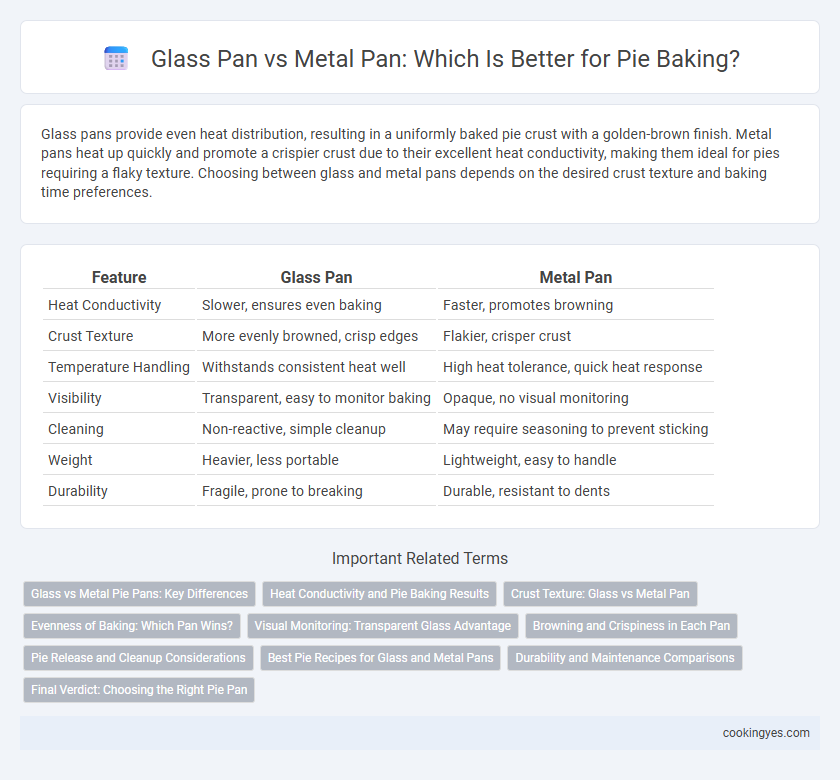Glass pans provide even heat distribution, resulting in a uniformly baked pie crust with a golden-brown finish. Metal pans heat up quickly and promote a crispier crust due to their excellent heat conductivity, making them ideal for pies requiring a flaky texture. Choosing between glass and metal pans depends on the desired crust texture and baking time preferences.
Table of Comparison
| Feature | Glass Pan | Metal Pan |
|---|---|---|
| Heat Conductivity | Slower, ensures even baking | Faster, promotes browning |
| Crust Texture | More evenly browned, crisp edges | Flakier, crisper crust |
| Temperature Handling | Withstands consistent heat well | High heat tolerance, quick heat response |
| Visibility | Transparent, easy to monitor baking | Opaque, no visual monitoring |
| Cleaning | Non-reactive, simple cleanup | May require seasoning to prevent sticking |
| Weight | Heavier, less portable | Lightweight, easy to handle |
| Durability | Fragile, prone to breaking | Durable, resistant to dents |
Glass vs Metal Pie Pans: Key Differences
Glass pie pans provide even heat distribution, allowing pies to bake uniformly and develop a golden crust, while metal pans heat up quickly and promote faster browning with a crisper crust. Glass pans are ideal for fruit pies as their transparency helps monitor browning and prevent burning, whereas metal pans excel with delicate pastry types due to their superior heat conduction. The choice between glass and metal pie pans affects baking time, crust texture, and overall pie quality, making it essential to select based on the pie type and desired results.
Heat Conductivity and Pie Baking Results
Glass pans retain heat longer than metal pans, promoting even baking and a moist filling for pies. Metal pans conduct heat faster, resulting in a crisper, golden crust but require close monitoring to prevent burning. Choosing between glass and metal pans depends on whether a tender, evenly cooked pie or a crispier crust is the priority.
Crust Texture: Glass vs Metal Pan
Glass pans distribute heat more evenly, resulting in a more uniformly baked pie crust with a tender texture and less browning. Metal pans, especially aluminum, conduct heat quickly, producing a crispier, browner crust ideal for flaky pie bottoms. Choosing glass enhances moist, delicate crusts, while metal is preferred for a crunchier, golden finish.
Evenness of Baking: Which Pan Wins?
Glass pans provide more even heat distribution during pie baking, reducing the risk of hot spots and ensuring consistent crust browning. Metal pans, particularly aluminum or steel, heat up faster and promote a crispier crust but may cause uneven edges if not monitored closely. For uniform baking results, glass pans typically offer better temperature control and stability compared to metal alternatives.
Visual Monitoring: Transparent Glass Advantage
Glass pans offer a clear advantage for visual monitoring during pie baking, allowing precise observation of crust browning without opening the oven. The transparent nature of glass ensures even heat circulation while enabling bakers to prevent undercooking or overcooking by checking the pie's edges and bottom. Metal pans, though efficient in heat conduction, lack this visibility, making glass pans the superior choice for visually tracking pie doneness.
Browning and Crispiness in Each Pan
Glass pans promote even heat distribution which enhances browning and produces a golden crust, while their transparent nature allows monitoring without opening the oven. Metal pans conduct heat more efficiently, resulting in faster browning and a crispier bottom crust, but may require careful temperature adjustments to prevent over-browning. Choosing between glass and metal pans depends on the desired crust texture, with metal preferred for crispiness and glass for consistent, evenly browned pies.
Pie Release and Cleanup Considerations
Glass pans offer excellent pie release due to their smooth, non-reactive surface, allowing crusts to bake evenly and brown nicely. Metal pans, especially those with non-stick coatings, facilitate easy pie removal but can sometimes cause uneven browning or sticking if not properly greased. Cleanup tends to be simpler with glass pans since batter residue rarely adheres strongly, while metal pans may require more thorough scrubbing to remove stuck-on residue.
Best Pie Recipes for Glass and Metal Pans
Glass pans provide even heat distribution, making them ideal for fruit pies with thick fillings, as the consistent heat helps the filling cook thoroughly without burning the crust. Metal pans, especially aluminum or steel, excel at conducting heat quickly, producing a perfectly crisp and golden crust, which is preferred for custard or cream pies that require a firm base. For best pie recipes, use glass pans for recipes like apple or cherry pies that benefit from slower baking, while metal pans are suited for pumpkin or pecan pies that require a well-browned crust.
Durability and Maintenance Comparisons
Glass pans offer moderate durability but are prone to cracking or shattering under sudden temperature changes, requiring careful handling and gradual cooling. Metal pans, especially those made of aluminum or stainless steel, exhibit superior durability, resisting warping and enduring high oven temperatures with less risk of damage. Maintenance of glass pans involves gentle cleaning to avoid scratches, while metal pans generally tolerate more rigorous scrubbing and are often dishwasher-safe, making them easier to maintain over time.
Final Verdict: Choosing the Right Pie Pan
Glass pans provide even heat distribution and allow for easy visual monitoring of pie crust browning, making them ideal for custard and fruit pies. Metal pans, especially aluminum or stainless steel, deliver superior heat conduction and create crispier, flakier crusts, preferred for savory or double-crust pies. Selecting the right pie pan depends on desired crust texture and recipe type, with glass excelling in gentle baking and metal offering robust, golden results.
Glass pan vs Metal pan for pie baking Infographic

 cookingyes.com
cookingyes.com